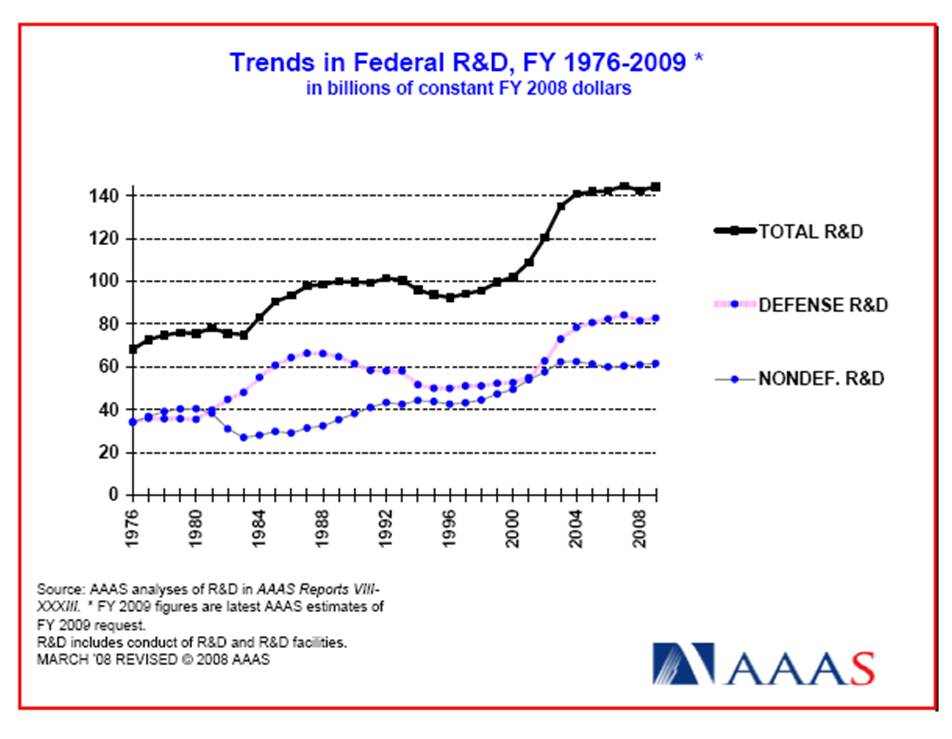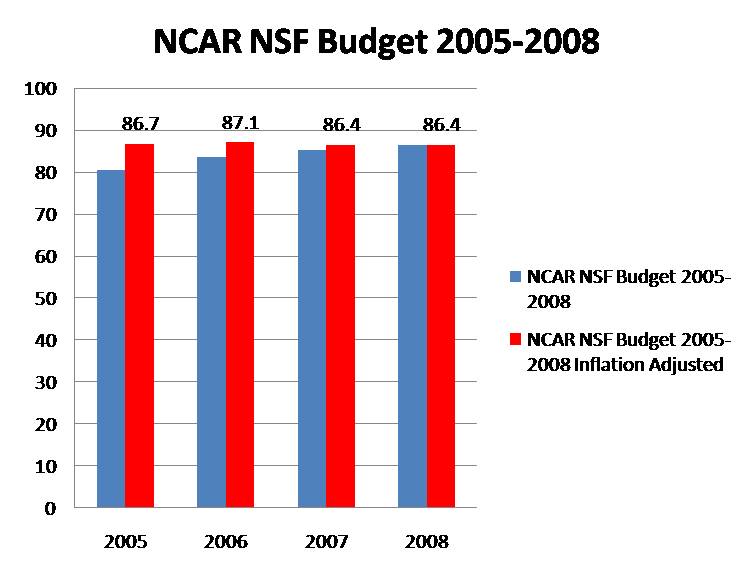NCAR’s NSF Budget: The Real Facts
August 9th, 2008Posted by: Roger Pielke, Jr.
On Friday, NCAR put out a press release with the following claims:
The National Center for Atmospheric Research, like many universities and other research institutions in the United States, continues to face extraordinary budget pressures, due to the decreases in real terms in federal funding for science. Over the past five years we have had to lay off over 50 people and have lost another 60 due to attrition, totaling roughly 12% of our NSF-supported staff, because of sub-inflationary National Science Foundation funding.
Several claims in this statement are misleading and even outright wrong.
First, have there been “decreases in real terms in federal funding for science?” No, there have not. The following figure from AAAS (PDF) shows that after adjusting for inflation budgets have been flat for the past several years, but certainly not decreasing. Nondefense science budgets have actually been increasing slightly after inflation.
That federal science budgets were going to plateau (at least) was fairly obvious in 2004. At the time I wrote:
Few seem to be aware that over the past decade S&T has experienced a second golden age, at least as measured by federal funding, which has increased dramatically in recent years at a pace not seen since the 1960s. But this second golden age is now ending and the consequences for science politics and policies are likely to be profound.
Second, NCAR’s press release also asserts that with respect to the NCAR allocation from NSF:
NSF and all of the government agencies that support science have faced similar budgetary stringencies. Over the past five years we have had to make painful cuts in all areas of our scientific and facilities programs—including climate, weather, atmospheric chemistry, solar physics and certain computational and observational facilities and services. . . Unfortunately, this year we are projecting a shortfall of $8 million (about 10%) in our NSF base budget and must plan for a worst-case shortfall next year of roughly $10 million.
Sounds dire, but the actual NSF data tells a very different story. The following shows the NSF allocation to NCAR for 2005-2008 (data from the NSF Budget www site) both in current and constant 2008 dollars (adjusted using the official implicit GDP price deflator).
The data show that in real terms the NCAR 2008 budget is about $0.3 million less than it was in 2005. How this situation translates into a shortfall of some $8 million — implying a need for 2005-2008 growth to be 10% above inflation — is beyond my reckoning. Perhaps NCAR has confused a lack of growth in desired spending with a budget cut, but who knows. Similarly, how a budget that grows almost exactly with inflation results in a loss of 12% of NSF-funded NCAR employees boggles the mind. They are either giving out huge raises or moving their spending away from people to equipment (like to the annual upkeep of an earmarked airplane, but I digress). Who knows what is going on at NCAR, but the spin and misdirection are not good signs.


August 11th, 2008 at 10:33 am
Again you cannot really use 2009 projected funding in any assessment. We”l be in a continuing resolution into the middle of next year – I’m sure we can both agree on that! However you read it 2004 to now, and to the forseeable future there will be an effective reduction in
NSF funding for science. And effective does not mean ‘inflation adjusted’ it mean what it actually costs (healthcare, fuel. maintenance costs, all greater than mean inflation). I’m sure if you look in the overhead charged on all the grants you apply for you will not see anything as low as inflation adjusted for the past few years. So, please DO argue about the virtue of whether they should have cut that program you deep important, but don’t suggest any budget decisions they are making are not really warranted or were not difficult to take.
August 11th, 2008 at 11:07 am
Rich-
Thanks for these comments.
If UCAR has problems with healthcare costs or fuel then it should say so publicly. Your comment is the first I have heard about that. The most recent press release and staff emails emphasized budgets from DC as the driving force behind the need for cuts, not increased programmatic expenses (Though Anthes did mention the cost of HIAPER in his statement).
At CU our heathcare costs have gone down in the past 2 years after increasing for a few. My overhead on grants has not changed.
I would welcome your insight on why 110 positions have been lost in a time of constant (after inflation) budgets. Surely that is not all going to fuel and maintenance?
August 11th, 2008 at 3:06 pm
Hi Roger,
Can you link to where you found the NCAR #s on the NSF budget site? I’m curious too about those data.. thanks! Lisa
August 11th, 2008 at 7:52 pm
The NCAR-wide numbers can be found in the NSF Research Infrastructure documents for each budget year. For FY 2009 (which includes the FY 2008 numbers), look at: http://www.nsf.gov/about/budget/fy2009/toc.jsp and click on NSF Research Infrastructure
Change the year in the URL for previous years.
The NSF budget information doesn’t drill down terribly far. For instance, if they have anything more than the line item for all of NCAR in the budget numbers, I couldn’t find it on their website.
The FY09 request, however, with a 9.5% increase, throws some wrinkles into the argument. Sure, it’s only a request, but it’s the rare agency that cuts in the face of proposed budget increases.
August 12th, 2008 at 11:32 am
Hi Lisa- Dave answered first and correctly! If you also want the deflator data, that is here:
http://research.stlouisfed.org/fred2/data/GDPDEF.txt
August 13th, 2008 at 2:05 pm
thanks Dave and Roger. I found really detailed info at http://dellweb.bfa.nsf.gov/, they have awards broken out by state and by institution etc. It’s still hard to break down how to classify the base NCAR award vs. the additional funding for individual grants etc. within UCAR (parent corporation for NCAR). The overall funding to UCAR over the last ten years does show a “dome shape” (I don’t know how to post a graph in the comments) — a ramp up from 1998 to 2002 from $94M to a high of $154M adjusted $2008 in 2002, then a ramp down to $112.9M in 2007. The past four years (‘04-’07) were $133, 108, 115, 113M (adjusted) in total funding from NSF to UCAR. Of course this not NCAR alone, but also included projects at UCAR.
I think the budget story is beyond these two sets of budget data though. From the staff communications of Rick and Tim (former director), FY2008 was a very difficult budget year, because there was a continuing resolution, where expected budgets did not end up arriving, and hoped-for growth did not materialize, as has already been mentioned. It is also my suspicion that costs at NCAR rise faster than the average economy-wide inflation, as is true for college costs (for reasons I do not know). I therefore think the budget story is not just hyperbole but was a real fiscal situation.
Nonetheless, we all know that merely having less money than anticipated does not automatically dictate which programs get cut. In my opinion there has been absolutely no justification provided that can explain why such an already small part of NCAR with such a large responsibility (ensuring that science can be useful to the public and decision makers) has been reduced so drastically. When the SERE laboratory was eliminated in early May of this year (the former parent administrative unit of CCB), the NCAR staff were assured by the former director of NCAR that “We want to emphasize that these changes in no way diminish UCAR’s and NCAR’s commitment to ASP, ISSE, and CCB. Despite the current budget challenges, we remain dedicated to our vision of developing leadership in the social science components of climate and weather research, creating societal and policy-relevant research and information products, and conducting research on human-environment interactions.”
Somehow this dedication has now vanished a mere 3 months later.
I also find it inexcusable that a very senior, very distinguished, tenured scientist has been simply “let go”. Mickey Glantz is synonymous with the term “usable science” and is world-renowned for his work to help especially those in developing countries respond to and anticipate climate-related disasters. After 34 years of service and building such an esteemed reputation for NCAR, this type of treatment is unjustified and does not reflect well on NCAR.
Beyond the personal aspect of the loss of Mickey for NCAR, I do wonder how NCAR plans to position itself as far as creating usable science. In this day and age, we need more commitment to creating usable science, not less. The Climate Change Science Program has re-emphasized its commitment to decision support, among many other programs. NSF is increasingly interdisciplinary and including broader impacts in its funding priorities. NCAR does not appear to be in sync with these broader trends. I can only hope it examines its budget and commitments and seeks to reverse this troubling trend.
August 13th, 2008 at 9:07 pm
Nature has a news story that provides some insight into the internal disputes about social science at NCAR. Linda Mearns, a former colleague of mine and top notch scientist but certainly not even remotely a social scientist, explains that people who do work like she does — integrated modeling — are welcome at NCAR, and implies that Mickey was not. From the Nature article:
““I don’t think this has anything to do with shutting down social science at NCAR,” says Linda Mearns, who recently stepped down as director of the Institute for the Study of Society and Environment there. Mearns says social scientists within the institute will continue to work with physical scientists at NCAR on integrated research projects. “And that’s the proper role for an institute in social science at NCAR.””
http://www.nature.com/news/2008/080812/full/454808a.html
In other words, she fits, but Mickey did not. Ouch.